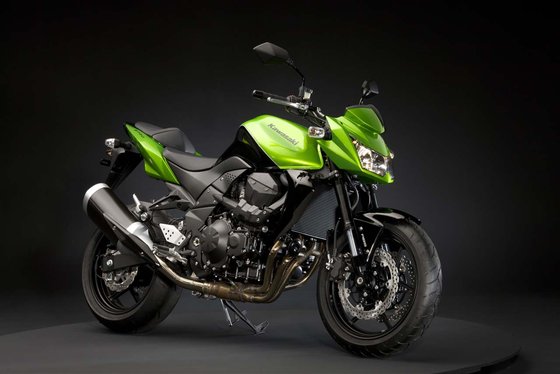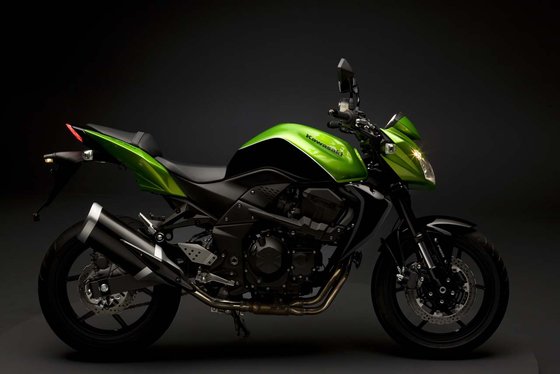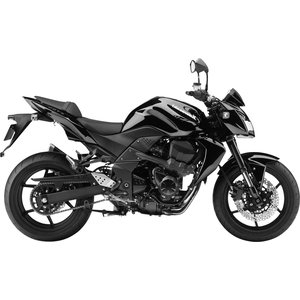Kawasaki Z750 (2007-2013) Review: The Streetfighter That Balances Fury and Practicality

When Kawasaki unleashed the Z750 in 2007, it wasn’t just another naked bike—it was a statement. Bridging the gap between hyper-aggressive liter bikes and tamer middleweights, the Z750 carved out a niche as a "true street performer." With its angular design, howling inline-four engine, and chassis tuned for urban agility, this motorcycle became a favorite for riders who wanted excitement without sacrificing everyday usability. Let’s dissect what made this generation iconic—and where it stands in the pantheon of naked bikes.
Design & Ergonomics: Aggressive Looks Meet Everyday Comfort
Visual Impact
The Z750’s design screams streetfighter. Its sharp, truncated tail section, exposed trellis frame, and twin underseat exhausts (on pre-2010 models) give it a mechanical rawness. The 2010 Urban Sports Special Edition upped the ante with a color-matched Akrapovic silencer and wheel rim stripes, while later models adopted a shorter, tri-oval exhaust for a cleaner profile. Kawasaki’s signature Candy Lime Green paint scheme ensured it stood out in traffic, though black and silver options offered subtler appeal.
Rider Triangle
With an 815 mm (32.1") seat height, the Z750 accommodates shorter riders without feeling cramped. The handlebars are positioned for a neutral, upright stance—ideal for city commutes but still leaned enough for spirited cornering. The tank’s narrow profile lets knees grip easily, though the stock seat’s foam thins out after an hour, pushing riders toward aftermarket solutions. Footpegs are mid-set, avoiding the cramped feel of supersports replicas.
Build Quality
The tubular steel frame and cast aluminum subframe strike a balance between rigidity and feedback. Fit-and-finish is typical Kawasaki: durable but not luxurious. Plastic components (like the radiator shrouds) feel utilitarian, but the 41 mm inverted forks and petal-style brake discs add a premium touch.
Engine & Performance: The Sweet Spot of Inline-Four Madness
Power Delivery
The 748 cc DOHC inline-four is the star here. With 106 HP @ 10,500 RPM and 78 Nm (57.5 lb-ft) of torque peaking around 8,300 RPM, it’s a masterclass in mid-range urgency. Throttle response is crisp, thanks to Keihin 32 mm throttle bodies with oval sub-throttles, though Euro 3 compliance introduced a slight flat spot at 4,000–5,000 RPM. Revving past 6,000 RPM unleashes a snarling crescendo, with a top speed of 233 km/h (145 mph)—enough to humble modern 600 cc supersports.
Real-World Usability
- 0–100 km/h (0–62 mph): 3.8 seconds
- Fuel Efficiency: 19.2 km/L (45 mpg)
- ¼-Mile: 11.2 seconds
The six-speed gearbox shifts smoothly, though the clutch can feel heavy in stop-and-go traffic. Fuel injection avoids the jerkiness of early EFI systems, and the 18.5L (4.9-gallon) tank offers a 320 km (200-mile) range—a boon for weekend rides.
Vibration & Sound
Relocated engine mounts (behind the cylinder head) reduce high-frequency buzz. The stock exhaust is muted at low RPM but growls angrily above 7,000 RPM. Swapping to an aftermarket slip-on (like Micron’s) amplifies the inline-four’s symphony without droning on highways.
Handling & Suspension: Precision With Room for Improvement
Chassis Dynamics
The Z750’s 1,440 mm (56.7") wheelbase and 24.5° rake strike a fine balance between stability and flickability. It’s no featherweight at 207–226 kg (456–498 lbs), but the weight hides low, making transitions between corners intuitive. Ground clearance is 155 mm (6.1"), sufficient for spirited riding without constant peg scraping.
Suspension Setup
- Front: 41 mm inverted forks (non-adjustable pre-2010, rebound-damping adjustability later)
- Rear: Bottom-Link Uni-Trak shock with 7-way preload adjustment
Stock suspension prioritizes comfort over precision. The forks dive under hard braking, and the shock wallows mid-corner on bumpy roads. Upgrading to Öhlins or Traxxion Dynamics components transforms the bike, as noted by long-term owners.
Braking Performance
Dual 300 mm petal discs with twin-piston calipers (four-piston on ABS models) offer strong initial bite. ABS, introduced in 2007, adds 4 kg (8.8 lbs) but is a lifesaver in wet conditions. The rear 220 mm disc lacks feel but suffices for routine stops.
Tires
Bridgestone BT019 (front) and BT012 (rear) provided grip for era-appropriate lean angles. Modern riders often switch to Michelin Road 5s or Pirelli Diablo Rosso IVs for better wet-weather performance.
Competition: How the Z750 Stacks Up Against Rivals
1. Yamaha FZ8 (2010–2013)
- Engine: 779 cc inline-four, 106 HP, 82 Nm
- Pros: Torquier low-end, smoother fueling
- Cons: Heavier (211 kg), softer suspension
The FZ8 matched the Z750’s power but emphasized low-RPM grunt. Its steel frame felt less communicative, and the seat was equally unforgiving.
2. Suzuki GSR750 (2011–2016)
- Engine: 749 cc inline-four, 106 HP, 80 Nm
- Pros: Lighter (211 kg), more refined throttle
- Cons: Bland styling, muted exhaust
Suzuki’s entry was more polished but lacked the Z750’s visual drama. Its slipper clutch was a boon for aggressive downshifts.
3. Triumph Street Triple 675 (2007–2012)
- Engine: 675 cc triple, 106 HP, 68 Nm
- Pros: 183 kg (403 lbs), telepathic handling
- Cons: Smaller displacement, buzzy at high speeds
The Street Triple’s triple-cylinder engine and lightweight chassis made it a canyon-carving favorite, though it trailed the Z750 in straight-line pull.
4. Honda CB600F Hornet (2007–2013)
- Engine: 599 cc inline-four, 102 HP, 63 Nm
- Pros: Smooth power delivery, bulletproof reliability
- Cons: Less character, softer suspension
Honda’s Hornet prioritized ease of use over excitement. Its smaller engine demanded higher revs, and the styling was conservative.
Verdict: The Z750’s blend of accessible power and sharp handling made it a standout. It lacked the Triumph’s agility or the Suzuki’s polish but offered a rawer, more visceral experience.
Maintenance: Keeping the Beast Alive
Key Service Intervals
- Oil Changes: Every 6,000 km (3,700 miles) with SAE 10W-40
- Chain Adjustment: Every 1,000 km (620 miles); use a 520-size chain with 112 links
- Valve Clearance: Every 24,000 km (15,000 miles)—a labor-intensive job requiring shims
Common Upgrades
1. Suspension: Swap to Öhlins shocks or Traxxion fork springs for sharper damping.
2. Seat: Corbin or Sargent seats alleviate numbness on long rides.
3. Exhaust: Akrapovic or Micron slip-ons shed weight and amplify the exhaust note.
4. Brakes: Steel-braided lines (e.g., Galfer) improve lever feel.
Troubleshooting Tips
- Warped Front Discs: Upgrade to wave-style rotors for better heat dissipation.
- Flat Spot at 4K RPM: A fuel controller (like Power Commander V) smooths throttle response.
- Vibrations: Bar-end weights or thicker grips reduce handlebar buzz.
Final Thoughts: A Streetfighter That Ages Gracefully
The Z750 isn’t perfect—its seat is a torture device, and the suspension needs tweaking—but its flaws are fixable. What remains is a motorcycle that thrills on backroads, commutes dutifully, and turns heads without pretension. For riders seeking a blank canvas to personalize, few bikes offer as much potential. And when you’re ready to elevate your Z750, MOTOPARTS.store has the upgrades to make it uniquely yours.






Specifications sheet
| Engine | |
|---|---|
| Stroke: | Four-stroke |
| Max power: | 106 kW | 142.0 hp |
| Max torque: | 78 Nm |
| Fuel system: | Fuel Injection (Keihin 32 mm x 4 with oval sub-throttles) |
| Max power @: | 10500 rpm |
| Displacement: | 748 ccm |
| Fuel control: | DOHC |
| Max torque @: | 8300 rpm |
| Bore x stroke: | 68.4 x 50.9 mm (2.7 x 2.0 in) |
| Configuration: | Inline |
| Cooling system: | Liquid |
| Compression ratio: | 11.3:1 |
| Number of cylinders: | 4 |
| Valves per cylinder: | 4 |
| Dimensions | |
|---|---|
| Wheelbase: | 1440 mm (56.7 in) |
| Dry weight: | 207 |
| Wet weight: | 226 |
| Seat height: | 815 mm (32.1 in) |
| Overall width: | 805 mm (31.7 in) |
| Overall height: | 1100 mm (43.3 in) |
| Overall length: | 2085 mm (82.1 in) |
| Ground clearance: | 155 mm (6.1 in) |
| Fuel tank capacity: | 18.5 L (4.8 US gal) |
| Drivetrain | |
|---|---|
| Chain size: | 520 |
| Chain links: | 112 |
| Final drive: | chain |
| Transmission: | 6-speed, wet multi-disc manual clutch |
| Rear sprocket: | 43 |
| Front sprocket: | 15 |
| Maintenance | |
|---|---|
| Rear tire: | 180/55-z-17 |
| Engine oil: | 10W40 |
| Front tire: | 120/70-z-17 |
| Brake fluid: | DOT 4 |
| Spark plugs: | NGK CR9EK or CR9EIX |
| Coolant capacity: | 3.0 |
| Engine oil capacity: | 3.3 |
| Engine oil change interval: | Every 5000 km or 2 years |
| Valve clearance (intake, cold): | 0.10–0.20 mm |
| Valve clearance check interval: | 24,000 km / 15,000 mi |
| Valve clearance (exhaust, cold): | 0.20–0.30 mm |
| Recommended tire pressure (rear): | 2.9 bar (42 psi) |
| Recommended tire pressure (front): | 2.5 bar (36 psi) |
| Chassis and Suspension | |
|---|---|
| Rake: | 24.5° |
| Frame: | Tubular backbone steel with cast aluminum engine sub-frame |
| Trail: | 103 mm (4.1 in) |
| Rear brakes: | Single 250 mm disc, 1-piston caliper (260 mm with ABS) |
| Front brakes: | Dual 300 mm petal discs, 2-piston calipers (ABS optional) |
| Rear suspension: | Bottom-Link Uni-Trak monoshock, 7-way adjustable preload |
| Front suspension: | 41 mm inverted fork, adjustable rebound damping and preload |
| Rear wheel travel: | 124 mm (4.9 in) |
| Front wheel travel: | 120 mm (4.7 in) |



















